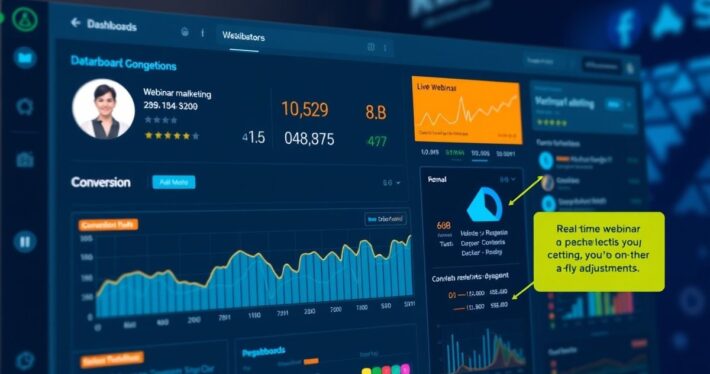Tracking Conversion Rates from Webinar to Sale
Mastering Webinar-to-Sale Conversion Tracking
Webinars are one of the most powerful tools in a marketer’s arsenal for driving sales, but they’re only as effective as your ability to measure their success. Tracking conversion rates from webinar to sale isn’t just about crunching numbers—it’s about understanding your audience, optimizing your funnel, and making data-driven decisions to boost ROI. Whether you’re a seasoned pro or just starting out, this guide will walk you through everything you need to know to master this critical aspect of webinar marketing.
Why Tracking Webinar Conversion Rates Matters
Let’s be honest: webinars take time, effort, and resources to create. If you’re not tracking how many attendees turn into paying customers, you’re essentially flying blind. But when done right, tracking conversion rates can reveal invaluable insights. Are your offers compelling enough? Is your audience engaged? Are you addressing their pain points effectively? These are questions that only data can answer.
I’ve seen businesses double their revenue simply by fine-tuning their webinar-to-sale process. For instance, one client increased their conversion rate by 30% just by adjusting their call-to-action timing based on analytics. The key? They stopped guessing and started tracking.
Setting Up a Robust Tracking System
Before you can optimize, you need to measure. Here’s a step-by-step guide to setting up a tracking system that works:
- Integrate Your Tools: Use platforms like HubSpot, Zoom, or WebinarJam that seamlessly integrate with your CRM and email marketing software. This ensures that every attendee’s journey is tracked from registration to purchase.
- Use UTM Parameters: Tag your webinar links with UTM parameters to track the source of your traffic. This helps you understand which marketing channels are driving the most engaged attendees.
- Leverage Analytics Dashboards: Tools like Google Analytics or Mixpanel can provide detailed insights into attendee behavior, such as how long they stayed during the webinar or which slides they engaged with most.
Understanding Key Metrics
Not all metrics are created equal. Here are the ones you should focus on for a comprehensive view of your webinar-to-sale funnel:
- Registration Rate: The percentage of people who sign up after seeing your promo. A low rate might indicate weak messaging or targeting.
- Attendance Rate: How many registrants actually show up? A drop-off here could signal poor timing or lack of reminders.
- Engagement Rate: Measures how actively attendees participate (e.g., Q&A, polls). High engagement often correlates with higher conversions.
- Conversion Rate: The ultimate metric—how many attendees become paying customers. This is your North Star for success.
Real-World Example: How Tracking Doubled Sales for Local E-commerce
One of my clients, an e-commerce store selling eco-friendly products, struggled with low webinar conversion rates. After implementing UTM tracking and analyzing attendee behavior, we discovered that most drop-offs occurred during the pricing pitch. By repositioning the offer and adding a risk-reversal guarantee (“100% money-back if you’re not satisfied”), they doubled their conversion rate within three webinars.
Optimizing Your Webinar for Higher Conversions
Now, here’s where it gets interesting: tracking is only half the battle. The other half is using that data to optimize your webinar for higher conversions. Here’s how:
- Craft a Compelling Offer: Use our AI-powered Webinar Offer Builder to structure pricing, stack value, and position your offer as irresistible. Pro tip: Add high-value bonuses created by our Bonus Brainstormer to sweeten the deal.
- Nail Your Call-to-Action: Timing is everything. Present your CTA when engagement is highest, usually after addressing a major pain point or presenting a solution.
- Address Objections: Use our Risk-Reversal/Guarantee Generator to create guarantees that make saying “yes” feel safer than saying “no.”
Common Challenges and How to Overcome Them
Even with the best tools, you’ll face challenges. Here are a few common ones and how to tackle them:
- Low Attendance Rates: If registrants aren’t showing up, try sending reminder emails with a value-packed teaser or rescheduling to a more convenient time.
- High Drop-Offs During the Webinar: Shorten your webinar or break it into smaller segments. Keep content engaging and interactive.
- Low Conversion Rates: Revisit your offer. Is it too complicated? Not aligned with attendee needs? Use data to refine and retest.
Tools to Simplify Conversion Tracking
If you’re not tech-savvy, don’t worry. There are tools that make tracking a breeze:
- Google Analytics: For advanced tracking and funnel analysis.
- CRM Software: Platforms like Salesforce or HubSpot to automate lead tracking.
- Webinar Platforms: Many modern platforms, like Demio or EverWebinar, come with built-in analytics dashboards.
The Future of Webinar Conversion Tracking
As AI continues to evolve, tracking and optimizing webinar conversions will become even more precise. Imagine tools that predict attendee behavior or offer real-time suggestions for improving conversions. It’s not sci-fi—it’s the near future.
So, are you ready to stop guessing and start tracking? With the right tools, strategies, and mindset, you can turn your webinars into a conversion powerhouse. Remember, data isn’t just numbers—it’s the story of your audience’s journey. And that story is the key to unlocking your sales potential.



